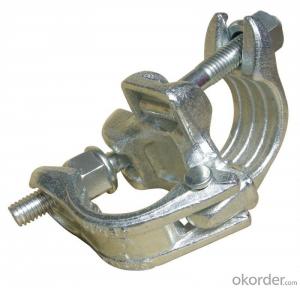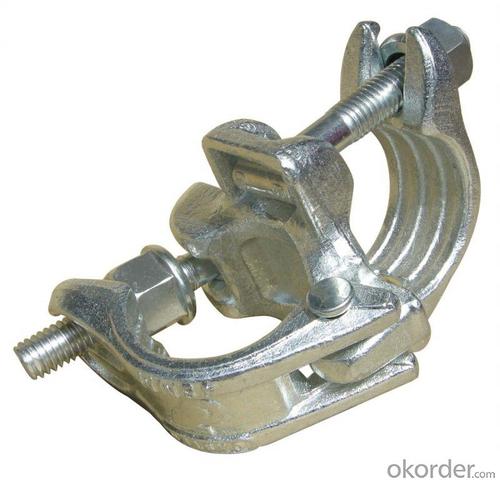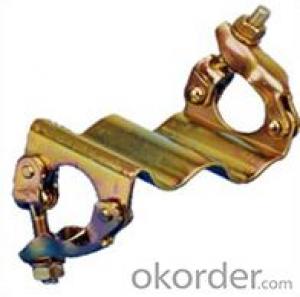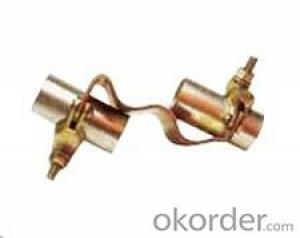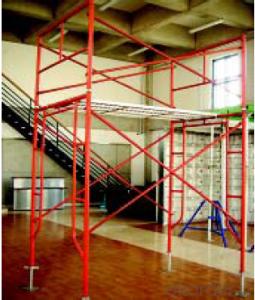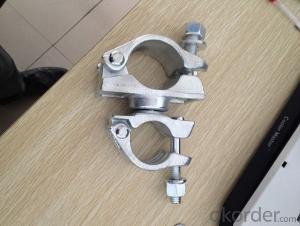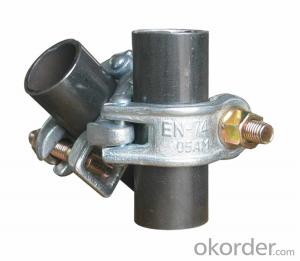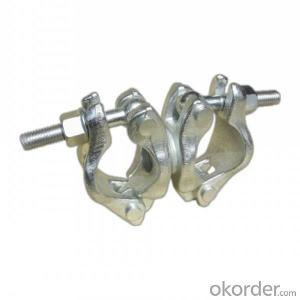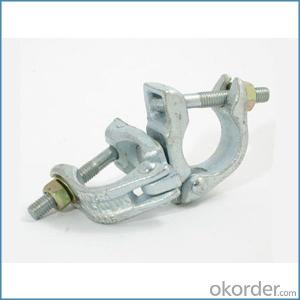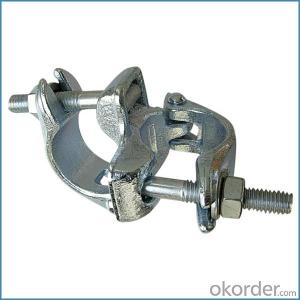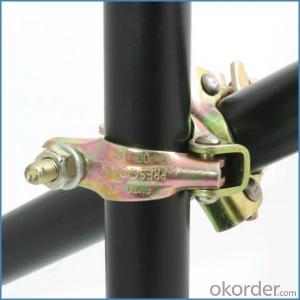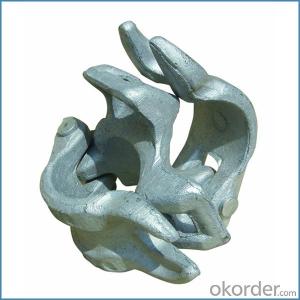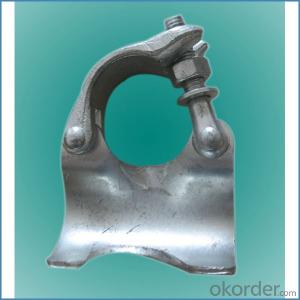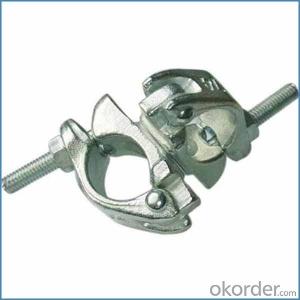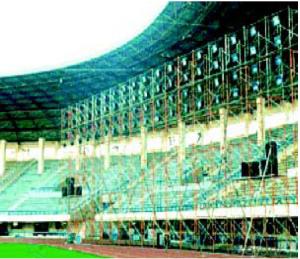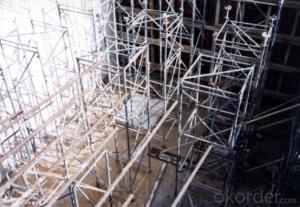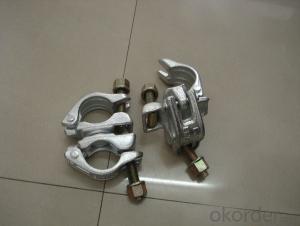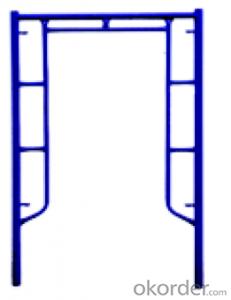Galvanized Scaffold Clamp British German Forged Type
- Loading Port:
- Tianjin
- Payment Terms:
- TT OR LC
- Min Order Qty:
- 1000 kg
- Supply Capability:
- 100000 kg/month
OKorder Service Pledge
OKorder Financial Service
You Might Also Like
Galvanized Scaffold Clamp British German Forged Type
Description
1.The scaffolding coupler is always used to connect the steel pipe as scaffolding system.
2.The often used coupler is swivel coupler and righ angle coupler .
3.We can provide types of scaffolding coupler according to your requirement.
4.Couoler can fix the 48.3mm scaffolding steel pipe tightly and make the whole scaffolding system more steadily.
Feature
(1)Excellent Anti-Breaking—Cold Pressed Steel
(2)Outstanding Resistance Deformation
(3)Strong Anti-Dropping Ability
Photo
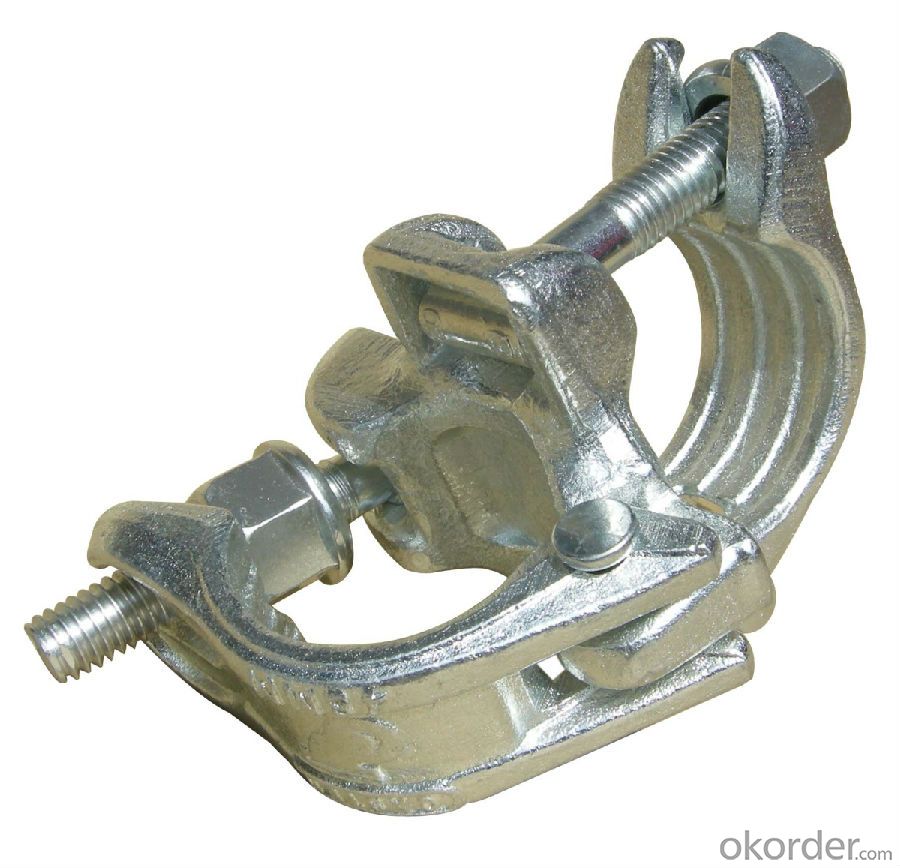
Parameter
| Material | Q235,345steel |
| Size | 48.3mm*48.3mm |
| Surface finish | Galvanized |
| Weight | 1.1kg around |
| Standard | BS1139,EN74 |
| Package | 25pcs/bag,steel pallet |
| Manufacture | As per customer requirement |
| Market | Africa, South America, the Middle East and Asia |
FAQ
Q: Are you a factory or trading company?
We are a state-owned corporation in China,dealing with various kinds of building materials.We have our holding subsidiaries.
Q: Where is your factory located? How can I visit there?
Our factory is located all around China.
Q: Can I get some samples?
Sample is free, customer only pay freight for the first time.
Q: Delivery?
10-30days. (5-15 containers)
Any question,feel free to contact us.
- Q: Are there any specific guidelines for the safe use of steel tube couplers in scaffolding near areas with high levels of airborne contaminants or pollutants?
- Steel tube couplers used in scaffolding near areas with high levels of airborne contaminants or pollutants require specific guidelines to ensure safe use. It is crucial to prioritize the health and safety of workers in such environments. To achieve this, the following measures should be taken: 1. Conduct a thorough risk assessment to identify potential hazards associated with airborne contaminants or pollutants present in the area. This assessment should consider the type, concentration, and toxicity of the contaminants. 2. Select steel tube couplers that resist corrosion and deterioration caused by the specific contaminants in the environment. Use high-quality materials that can withstand exposure to airborne pollutants. 3. Regularly inspect the steel tube couplers to detect any signs of corrosion, deterioration, or damage that could compromise their integrity. Replace any couplers showing wear and tear or unsuitable for use. 4. Implement appropriate protective measures to minimize workers' exposure to airborne contaminants. This includes providing suitable personal protective equipment (PPE) like respirators, gloves, and protective clothing. Promote proper hygiene practices such as hand and face washing after work. 5. Provide comprehensive training to workers regarding the potential hazards associated with working in areas with high levels of airborne contaminants or pollutants. Train them on the correct use of PPE and safe work practices to reduce exposure risks. 6. Ensure the scaffolding area has adequate ventilation to decrease the concentration of airborne contaminants. This can be achieved through the use of fans, air purifiers, or positioning the scaffolding in areas with better air quality. 7. Regularly clean and maintain the scaffolding equipment, including the steel tube couplers, to prevent the accumulation of contaminants that could compromise their structural integrity. 8. Comply with all relevant safety regulations, standards, and guidelines set by local authorities and regulatory bodies. Adhere to any additional specific guidelines provided for working with scaffolding in areas with high levels of airborne contaminants. By adhering to these guidelines, employers can minimize the risks associated with using steel tube couplers in scaffolding near areas with high levels of airborne contaminants or pollutants, ensuring the safety and well-being of workers.
- Q: Can steel tube couplers be used in scaffolding projects with limited access?
- Indeed, in scaffolding projects with limited access, steel tube couplers can be utilized. These couplers possess great versatility as they can be effortlessly affixed to tubes, forming a scaffolding structure that is both secure and steady. In construction endeavors confronted with cramped or challenging circumstances, where conventional scaffolding systems cannot be conveniently erected, these couplers are commonly employed. By enabling the construction of scaffolding in constricted or enclosed areas, they prove to be ideal for projects with restricted accessibility. Furthermore, the employment of steel tube couplers guarantees a robust and dependable connection between tubes, thereby ensuring the safety and stability of the scaffolding structure.
- Q: How often should steel tube couplers be inspected for damage or wear?
- Steel tube couplers should be inspected for damage or wear regularly, ideally on a quarterly basis. However, the frequency of inspections may vary depending on the specific usage and conditions the couplers are exposed to. In high-traffic or harsh environments, more frequent inspections, such as monthly or even weekly, should be considered. It is essential to prioritize safety and ensure that any potential issues with the couplers are detected early on. Regular inspections allow for timely repairs or replacements, minimizing the risk of accidents or failures. Additionally, adhering to manufacturer recommendations and industry standards can provide guidance on the recommended inspection frequency for steel tube couplers.
- Q: Are there any specific guidelines for using steel tube couplers in scaffolding systems that need to accommodate different weight distributions?
- There exist specific guidelines for the utilization of steel tube couplers in scaffolding systems that must accommodate various weight distributions. To begin with, it is of utmost importance to verify that the steel tube couplers employed are specifically designed and manufactured for scaffolding purposes. These couplers ought to conform to applicable industry standards and regulations, such as the Occupational Safety and Health Administration (OSHA) standards in the United States or the European Norm (EN) standards in Europe. When employing steel tube couplers in scaffolding systems, it is crucial to take into account the maximum load capacity and weight distribution of the system. This information should be provided by the manufacturer and strictly adhered to during the design and assembly of the scaffolding. Concerning weight distribution, the scaffolding system should be designed and set up in a manner that guarantees an even and balanced distribution of the load. This can be achieved by appropriately spacing the steel tube couplers and ensuring that the load is evenly distributed across the supporting members. Furthermore, it is important to consider the type of scaffolding structure being utilized and the intended purpose of the system. Diverse scaffolding structures, such as single or double coupler systems, may possess distinct weight distribution requirements. Consequently, it is imperative to adhere to the manufacturer's guidelines and recommendations for the specific scaffolding system in use. Regular inspections and maintenance of the steel tube couplers are also vital to ensure the integrity and safety of the scaffolding system. This entails inspecting for any indications of wear, damage, or corrosion and promptly replacing any faulty or damaged couplers. In conclusion, proper planning, adherence to manufacturer's guidelines, and regular inspections are indispensable for the utilization of steel tube couplers in scaffolding systems that need to accommodate different weight distributions. By adhering to these guidelines, the risk of accidents or structural failures can be minimized, ensuring the safety of workers and other individuals utilizing the scaffolding system.
- Q: I had my cartilage pierced at a studio with a needle [ not a gun ] 5 months ago.The bottom hole was pierced on the rim of my ear, but sadly a bit too close to the surface. My industrial bar fits fine but i am not happy with the placement anymore.Even when i wear dark jewelry in my ear you can see it through my skin. I'm scared that if i catch it it will tear because its not in the thickst bit of cartilage. The piercer obviously didn't know what he was doing because he didnt pierce it far back enough..I wish i had realised at the time but the fact that it was close to the surface wasnt noticable until someone mentioned it.I am wondering will the hole close up if i take out the jewelry and can i get it re pierced firther back because i still want an industrial..i also am wondering if i will be left with a noticable scar? can i get it re-pierced?and has anyone ever had the same kinda thing happen to them?thanks